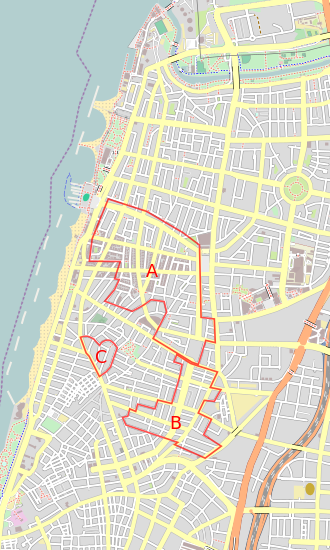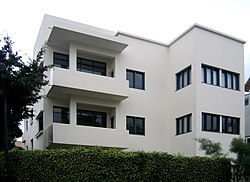Museu Bauhaus em Tel Aviv
Tel Aviv é a cidade com mais arquitetura da escola de Bauhaus. Há mais edifícios construídos segundo o estilo Bauhaus que em qualquer outro lugar do mundo, incluindo qualquer cidade alemã. O estilo foi levado na década de 1930 por arquitectos judeus europeus que fugiram do regime nazi.
Sua filosofia básica previa a construção rápida de residências econômicas e funcionais, com um desperdício mínimo de espaço. Com espaços plantados entre os prédios.(A construção da cidade seguiu o plano mestre de "cidade-jardim" elaborado por Patrick Geddes. Edifícios de dois e três andares foram intercalados com avenidas e parques públicos)
Desde 2003, a zona da cidade conhecida como Cidade Branca foi declarada Património Mundial pela UNESCO, sendo mais de 1500 os edifícios International Style contabilizados e sujeitos a diversos planos de restauração e preservação.
Apesar de terem surgido novos estilos arquitectónicos – incluindo modernos arranha-céus – o modelo dominante de Tel Aviv quando vista do ar e ainda a profusão de "pequenos edifícios com forma de caixas e tecto branco" que reflectem a tradição Bauhaus da arquitectura modernista da cidade.
https://pt.wikipedia.org/wiki/Cidade_Branca_de_Tel_Aviv
Hoje, com o crescimento das árvores, já se poderia dizer que Tel Aviv é uma CIDADE VERDE!
Já nem se veem muitos prédios....
Como o povo israeli adora praças e parques, a cidade verde é um convite à convivência.
"A surpresa de encontrar laranjeiras, limoeiros, romãs, alecrim, sálvia, maracujá e árvores frondosas com mais de 50 anos, pelas ruas de Tel Aviv,me devolveu a conexão com a Bauhaus, que eu havia estudado e me apaixonado na Faculdade de Arquitetura, 1976.
A cidade foi concebida por arquitetos provindos da BauHaus alemã, sonhando um espaço de relacionamento numa cidade jardim, nos anos 30. Os prédios são blocos parecidos, simples, de materiais populares, e tem espaços entre eles, onde há vegetação.
Hoje as árvores refrescam o calor do verão mediterrâneo, quente e seco. Grandes alamedas, como a Sderot Chen, próxima à Prefeitura, e onde está o Centro Cultural Brasileiro, ligado à Embaixada, tem um belo bosque urbano usado pelas pessoas todos os dias.
A cultura da jardinagem e a presença de fontes em Israel podem ter origem na época da Al- Andaluz, o que conhecemos por Espanha Islâmica, na península ibérica, banhada pelo Mediterrâneo, quando judeus, muçulmanos e cristãos viveram em período de relacionamento criativo entre os sécs. VIII e XIV.
A cultura de aproximar diferenças e dar soluções positivas coletivas nesse período muçulmano gerou uma paixão por cultura, arquitetura, artes,
construindo bibliotecas, jardins com agricultura, utilizando as águas para
refrescar o ambiente e como elemento de introspecção religiosa.
Maria Rosa Menescal. em tese apresentada no livro “Ornament of the World, How Muslims, Jews, and Christians Created a Culture of Tolerance in Medieval Spain” conta um período muito profícuo da história, bastante desconhecido.
Os três jardins mais antigos da Europa e que ainda se conservam são do tempo árabe-andaluz: Alhambra, Generalife e o Alcazar de Cordoba.
(Estes informes estao na postagem: http://claudialulkin.blogspot.com.br/2015/11/paisagismo-alimentar-contribuicao-de.html)
E é possível encontrar "enCantinhos" com "enCanteiros", com capuchinhas, abóbora, tomate....
http://blog.planalto.gov.br/o-sonho-modernista-das-cidades-de-tel-aviv-e-brasilia
Domingo, 14 de março de 2010 às 11:11
Tel Aviv, em Israel, e Brasília compartilham o mesmo sonho modernista

Por estar à beira do Mar Mediterrâneo, ter sol quase o ano inteiro e ser um popular destino turístico, com muitos bares, restaurantes e estilo de vida cosmopolita, Tel Aviv lembra muito o Rio de Janeiro. Mas a segunda maior cidade de Israel, fundada há 100 anos, é considerada irmã de corpo e alma de uma outra cidade brasileira, com metade de sua idade: Brasília. Ambas nasceram no meio de regiões áridas, fruto do sonho de seus futuros moradores, e têm em suas origens a influência de dois importantes momentos da arquitetura modernista (a alemã Bauhaus e a francesa de Le Corbusier), que lhes garantiu a honraria de serem consideradas Patrimônio Cultural da Humanidade pela Unesco.
Para entender melhor essas semelhanças, o Blog do Planalto conversou com o arquiteto brasileiro Sérgio Lerman, que mora em Tel Aviv há 40 anos e foi um dos responsáveis pela recuperação do patrimônio mais singular da cidade: seus prédios de estilo Bauhaus, movimento modernista alemão que teve seu auge na década de 1930. São mais de 2 mil edifícios por toda a cidade, o que levou Tel Aviv a ser conhecida como a Cidade Branca, por causa da cor predominante desses prédios. Veja aqui alguns desses prédios.
“O DNA das duas cidades veio da arquitetura moderna. A Bauhaus influenciou muito o arquiteto Le Corbusier que, por sua vez, influenciou Oscar Niemeyer e Lúcio Costa, os responsáveis por Brasília”, disse Lerman durante conversa em um café próximo ao centro histórico de Tel Aviv. Mostrando uma foto em que alguns colonos judeus se reúnem para comprar os primeiros lotes no meio do deserto, em meio a dunas e barracas, onde dormiam enquanto as primeiras casas não eram construídas, Lerman afirma que a visão dos pioneiros de Tel Aviv e de Brasília também é muito similar:
As cidades foram construídas do zero. Não existiam antes. Tel Aviv nasceu no meio das dunas de areia, Brasília no meio do barro do Planalto Central. Ambas pelo esforço de milhares de pessoas – judeus que vieram de todo o mundo e brasileiros que vieram de todas as regiões do País. Tel Aviv foi o sonho dos peregrinos judeus, assim como Brasília foi a cidade dos sonhos de todos os brasileiros que ajudaram a construi-la. E os edifícios das duas cidades traduzem esses sonhos.
Lerman, que trabalhou por 10 anos (1985-1996) na prefeitura de Tel Aviv como seu arquiteto-chefe e hoje dá aulas de preservação de edifícios na Universidade de Tel Aviv, nos leva então para conhecer in loco alguns dos prédios com influência Bauhaus no centro de Tel Aviv, pelo boulevard Rothschild, onde tudo começou. Nesse tour guiado por um especialista, fica mais fácil entender as muitas semelhanças arquitetônicas entre a cidade israelense e a capital brasileira.
“O estilo arquitetônico aqui é da década de 1930 e, em Brasília, dos anos 50, mas a escola é a mesma, a moderna”, afirma o arquiteto brasileiro, destacando que o planejamento urbano das duas cidades também é bastante similar. O escocês Patrick Geddes teve ideias nos anos 20 para Tel Aviv muito parecidas com as superquadras de Brasília, com muito espaço verde e centros comerciais localizados. A organização e funcionalidade do espaço urbano eram requisitos básicos tanto para Geddes como para Lúcio Costa.
O estilo modernista chegou a Tel Aviv no início dos anos 30 juntamente com os arquitetos judeus alemães que estudaram na escola Bauhaus na Alemanha. Sua filosofia básica previa a construção rápida de residências econômicas e funcionais, com um desperdício mínimo de espaço. “Toda a construção pública e muitas privadas em Tel Aviv foram baseadas na Bauhaus nesse período”, afirmou Lerman. “E isso caiu muito bem com o planejamento de Geddes, que pensou a cidade para ser um lugar prazeiroso para todos, uma cidade-jardim, bem no espírito socialista do movimento Bauhaus. Brasília é a versão brasileira e ainda mais moderna desse sonho.
O Centro BauHaus, que leva a uma visita de uma parte da região central, nas sextas-feiras, também está no facebook!
https://www.facebook.com/bauhaus.center?ref=ts&fref=ts












































